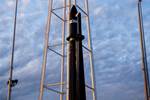Rocket Lab launches climate science satellites for NASA
The first of two satellites were deployed on the company’s composite Electron rocket for the PREFIRE mission to detect heat loss over the Arctic and Antarctica.
Shown here are the twin Electron fairings for NASA’s two PREFIRE launches. Source (All Images) | Rocket Lab USA Inc.
On May 25, Rocket Lab USA Inc. (Long Beach, Calif., U.S.) launched the first of two back-to-back launches for NASA’s (Washington, D.C., U.S.) Polar Radiant Energy in the Far-InfraRed Experiment (PREFIRE) mission, specifically tasked with measuring heat loss from both the Arctic and Antarctica, in an aim to help researchers better understand Earth’s energy budget. The launch was achieved via the company’s composite Electron rocket.
‘Ready, Aim, PREFIRE’ lifted off from Rocket Lab Launch Complex 1 in Mahia, New Zealand, at 7:41 p.m. NZST. The launch deployed the first of two satellites for the PREFIRE mission to a 525-kilometer circular low Earth orbit (LEO). Now that the first satellite has been successfully deployed, the second will follow on another dedicated Electron launch in just a few days. The launch date for the next mission, ‘PREFIRE and Ice’ will be confirmed early next week.
Rocket Lab’s ability to launch dedicated missions to precise orbits on demand is critical to the success of PREFIRE. The mission requires two separate satellites to follow similar trajectories but along different paths to overlap with each other every few hours near the Arctic and Antarctica and capture accurate heat loss measurements. Both PREFIRE satellites are equipped with a device called a thermopile, similar to sensors found in household thermostats, to measure heat loss at far-infrared wavelengths which have never been systematically measured before, according to the company. This data collected by the PREFIRE mission will help to improve climate and ice models and provide better predictions of how the planet’s sea level and weather are likely to change in the future. Watch the complete launch in the video below.
“Missions like PREFIRE demonstrate the benefit of Electron — dedicated launch for small satellites to precise orbits on precise schedules,” Rocket Lab founder and CEO, Peter Beck, says. “We’ve demonstrated this back-to-back launch capability for NASA once before with the TROPICS mission [May 2023] and we’re excited to deliver it once again for PREFIRE.”
This successful mission was Rocket Lab’s 48th Electron launch overall and sixth launch of 2024.
Related Content
-
Daher CARAC TP project advances thermoplastic composites certification approach
New tests, analysis enable databases, models, design guidelines and methodologies, combining materials science with production processes to predict and optimize part performance at temperatures above Tg (≈150-180°C) for wing and engine structures.
-
TU Munich develops cuboidal conformable tanks using carbon fiber composites for increased hydrogen storage
Flat tank enabling standard platform for BEV and FCEV uses thermoplastic and thermoset composites, overwrapped skeleton design in pursuit of 25% more H2 storage.
-
Syensqo becomes new Solvay specialty materials company
Syensqo represents what was Solvay Composite Materials, focused on delivering disruptive material technologies and supporting growing customer needs.


















